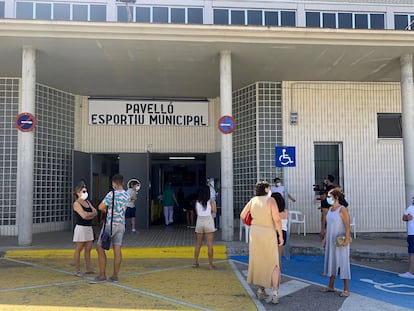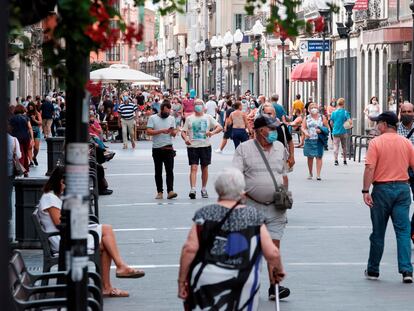August ends with more than 5,000 new coronavirus cases a day in Spain, five times those detected in July
The Health Ministry has reported 23,572 infections and a further 83 victims since Friday, with one expert calling the progress of the epidemic “very worrying”

The coronavirus did not take a summer break in Spain. According to figures released last night by the country’s Health Ministry, a total of 174,336 new cases were diagnosed during the month of August, with 23,572 detected since Friday alone. That works out as an average of 5,623 a day. This figure is almost five times higher than that of July, and confirms a second wave of the virus that is not showing any signs of losing strength across Spain as a whole.
The figures supplied on Monday by the Health Ministry recorded 83 new Covid-19-related fatalities, bringing the official death toll since the crisis began to 29,094. More than half of these latest victims were notified from the Madrid region.
For Fernando Simón, the director of the Health Ministry’s Coordination Center for Health Alerts (CCAES), and the visible face of the government during the ongoing coronavirus crisis, this past month has been “bitter-sweet.” Speaking on Monday evening, he admitted that there had been “very significant” rises in the indicators, but he also pointed to positive factors. For example, diagnostic capacity is now double what it was in July, but the rate of asymptomatic cases is falling. Another factor the chief epidemiologist pointed to was that there have not been more outbreaks among seasonal fruit pickers, something the ministry had been concerned about. Meanwhile, the size of the outbreaks that originated in social settings “is falling,” and perhaps the most encouraging, the regions with the biggest growth in cases in July have managed to stabilize transmission – i.e. in Catalonia – or reduce it, as has happened in Aragón.
The population shouldn’t be distressed but they should be concernedFernando Simón, director of the Health Ministry’s Coordination Center for Health Alerts
“The rise is bigger than we would have liked, but it’s to be expected,” the CCAES chief said on Monday. “We are detecting nearly as many cases as we did at the peak of March and April but things are completely different to how they were then,” he continued. “But we cannot sleep easy, at least not us,” he said in reference to his team. “The population shouldn’t be distressed but they should be concerned.”
Ildefonso Hernández, a public health professor and spokesperson for the Spanish Public Health Society (SESPAS), agreed with Simón in that the cases in Aragón and to a lesser extent Catalonia can be seen as encouraging, but he classed the progress of the epidemic as “very worrying.” “What has been illustrated in the month of August is that the epidemiological monitoring, early detection and contact tracing has not been taken seriously,” he said. “If this is not done well we are going to have problems in the future.”
The second wave began in Aragón and Catalonia, and from there it spread to the capitals of those regions
The expert also pointed to the “haste” to restart certain activities, such as nightlife, and which has ended up being counterproductive. “What’s more, I believe that communication has been a failure on issues such as face masks. It is true that people wear them in general on the street, but this is perhaps where it is least necessary to do so,” he concluded in reference to closed spaces, where the face coverings are much more useful.
The second wave began in Aragón and Catalonia, and from there it spread to the capitals of those regions, where there is high citizen mobility and population density – in particular in Barcelona. This was followed by northern regions such as Navarre and the Basque Country, with outbreaks in residences and healthcare centers, but in particular at social events. Finally the second wave began to be seen in Valencia, Andalusia and Madrid, the latter region accounting for one in every five cases in Spain and becoming – once again – the focal point of the outbreak in Spain.
This, Simón explained, coincides with all of the journeys people have taken in order to enjoy their summer vacations. “While these [journeys] have been fewer than in other years, they have happened,” he said. “There has been a mixing of people from areas that had high transmission rates and others that had very low ones. We don’t know if the return from holidays in July could have affected Madrid, but it is true that many Madrileños have been outside with other groups and the chance that this has happened is high,” Simón explained, admitting that the interaction of travelers in the capital “causes concern.” “Madrid has a high risk because fortunately and unfortunately it is the basic hub for all transportation in Spain,” he concluded.
A warning
The situation in the Madrid region is particularly concerning because hospital occupation continues to rise there. Since the Health Ministry began publishing this data point, on August 20, Covid-19 patients have risen from 1,245 to 2,128, which is an increase of 70%. Intensive care unit (ICU) admissions, meanwhile, have gone up from 126 to 218, which is a 73% rise. While the occupation of beds by coronavirus patients is at 16%, which is far from capacity, this could change in just weeks if current growth rates hold steady.
The second region with highest hospital occupation is Aragón, with 13%. The big difference is that there, the figures are not growing and have held steady for the last two weeks. In Spain as a whole, the average is 6% of Covid-19 patients with respect to total capacity. Hernández, from SESPAS, believes that the figures are a warning that the situation “could get worse.”
English version by Simon Hunter.
Tu suscripción se está usando en otro dispositivo
¿Quieres añadir otro usuario a tu suscripción?
Si continúas leyendo en este dispositivo, no se podrá leer en el otro.
FlechaTu suscripción se está usando en otro dispositivo y solo puedes acceder a EL PAÍS desde un dispositivo a la vez.
Si quieres compartir tu cuenta, cambia tu suscripción a la modalidad Premium, así podrás añadir otro usuario. Cada uno accederá con su propia cuenta de email, lo que os permitirá personalizar vuestra experiencia en EL PAÍS.
¿Tienes una suscripción de empresa? Accede aquí para contratar más cuentas.
En el caso de no saber quién está usando tu cuenta, te recomendamos cambiar tu contraseña aquí.
Si decides continuar compartiendo tu cuenta, este mensaje se mostrará en tu dispositivo y en el de la otra persona que está usando tu cuenta de forma indefinida, afectando a tu experiencia de lectura. Puedes consultar aquí los términos y condiciones de la suscripción digital.
More information
Últimas noticias
Most viewed
- Reinhard Genzel, Nobel laureate in physics: ‘One-minute videos will never give you the truth’
- Oona Chaplin: ‘I told James Cameron that I was living in a treehouse and starting a permaculture project with a friend’
- Pablo Escobar’s hippos: A serious environmental problem, 40 years on
- Charles Dubouloz, mountaineering star, retires at 36 with a farewell tour inspired by Walter Bonatti
- Why we lost the habit of sleeping in two segments and how that changed our sense of time











































